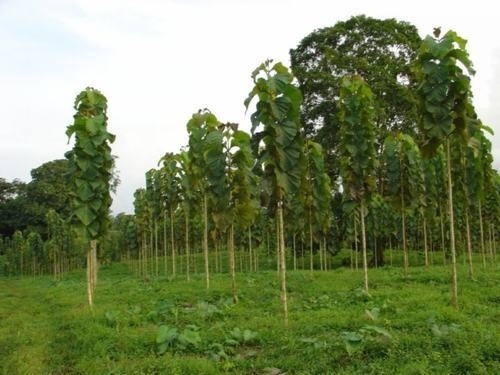Sagwan Tree Plantation

Sagwan (Teak) is tropical hardwood species and belong to family of Lamiaceae. It is most valuable and high price timber crop of India. It is deciduous tall tree upto 40 m tall with grey to greyish brown branches. In India, sagwan plantation take place in 1842 and Chatu Menon from Kerala state is known as "Father of Indian Teak Plantation". It is most important hardwood and use for making of furniture, plywoods, all types of construction pole, ship building etc.
CLIMATE
Temperature:10-45°C
Rainfall:1200-2500mm
Sowing Temperature:30-35°C
Harvesting Temperature:10-45°C
SOIL
For good growth, it required well drained, deep and fertile soil. pH of soil should be 6.5 or above. Growth of plant get affected when pH is less 6.5.
LAND PREPARATION
Plough land for two three times and bring soil to fine tilth. Also level soil to avoid water stagnation in field. For seedling transplantation dig pits of 45 cm x 45 cm x 45 cm. Mixed well decomposed cow dung along with insecticides in each pit.
SOWING
Time of sowing: Seeds are sown in nursery beds. Seedlings of 12-15 months are used for stumps preparation for planting. Clonal propagation done through grafting, rooted stem cutting and micro propagation. For planting use pre sprouted stumps. Monsoon is best season for teak plantation.
Spacing: For planting use spacing of 2 m x 2 m or 2.5 m x 2.5 m or 3 m x 3 m. When intercrop is taken spacing of 4 m x 4 m or 5 m x 5 m can be used.
Sowing Depth: For planting sagwan pre sprouted stumps, dig pit of 45 cm x 45 cm x 45 cm and fill pit with soil and well decomposed cow dung.
Method of Sowing: Sowing can be done by Line Sowing, Broadcasting or Transplanting method.
SEED
Seed Rate: Approximately 1500-1800 clones required for planting in one acre area.
Seed Treatment: Fruits of teak plant cover with thick and hard mesocarp therefore before sowing in nursery various pre-treatments are done on seeds of sagwan to increased germination percentage. Traditional simple method of pre-treatment is alternate soaking and drying of fruits. In this method seeds are soaked in water for 12 hours then dry in sun for 12 hour. This process of wetting and drying is repeated for 10-14 days. Acid method and pit methods are other methods of pre-treatment.
FERTILIZER
In August and September month of every year apply N:P:K (15:15:15)@50gm per plant for first three years.
WEED CONTROL
During first three years establishment, intense weeding is necessary to keep weed free. Carry out weeding operations on regular basis. In first year, take three weeding operation and in second year, carry out two weeding operations. Take one weeding operation in third year of plantation.
IRRIGATION
In monsoon month no irrigations are required. Apply irrigation in hot or summer month or during stress periods. Irrigation during stress period improve yield to great extent. Excess irrigation would leads to development of water blisters and spread fungi.
PLANT PROTECTION
Pest and their control: Teak defoliator, skeletonize are serious pest of teak and they damaged tree to greater extent. To get rid of this pest spray with quinalphos@300ml/ 150 ltr of water.
Disease and their control: Pink disease, powdery mildew and root rot are major disease of teak plant. It can be controlled by spraying of M-45@400gm per acre.
HARVESTING
When tree approaches at harvesting state, mark that trees and submit report to "Chief Regional Forestry Office". After getting permission harvesting can be done. Teak farming is highly profitable farming as it has great demand in India as well as abroad. In 14 years each teak tree yield about 10-15 cubic feet wood.
